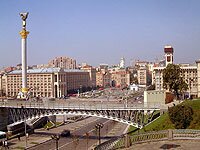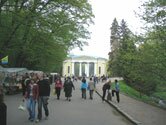
MUST SEE PLACES IN KIEV
Khreshatik and Independence Square
Khreshatyk is the main street of Kiev. With a tree alley on one side and no traffic on weekends and holidays, people gather to sit, chat and drink here. Every weekend there is an event or a concert taking place or at least music is played. On one end of Khreshatik there is the famous Bessarabka market - originally it was a market with goods brought by peasants from Bessarabia - Moldova. Today, the ground floor is fully occupied by vegetables, fruits, flowers, spices, meat, cheese, fish, caviar and other specialities and all the vendors are trying to pull you to their stand to try and buy. It is one of the few places where you can get any kind of fruit or vegetable all year round but it will also cost you. From outside, the building is filled with restaurants, snack bars, shops and cafes. There is a non stop tearoom, sushi bar, pizza fast food and other venues. Walking to the other end of the 1300 meters long street you'll get to Maidan Nezalezhnosti (Independence Square). The square is a mixture of different styles - the Soviet type hotel Ukraine, the modern glass hemisphere of the shopping center, the Monument to the Independence - a column rising 50 meters high and so on.
Kyiv-Pechersk Lavra
Lavra means 'monastery' and Pechersk is a name derived from 'pechery' meaning 'caves'. That and more you will find when visiting the most significant sightseeing point in Kiev. It is the oldest Orthodox monastery in Ukraine that attracted thousands of pilgrims and many monks. The buildings were destroyed by fire and later also during the Nazi occupation but it was always reconstructed. Nowadays it is a UNESCO heritage with lots of tourists visiting. The caves are small and narrow, stretching several hundred meters and up to 20 meters under ground. Some of the monks dug into their caves and decided to stay there forever with just a small hole allowing food and water to be passed in. Once dead, they were left and buried there - you can see the embalmed bodies in glass coffins. The caves are a very holy place and you have to dress appropriately to get in, women need to cover their head with a scarf (own or borrowed or bought on the spot). Apart from the caves you can climb up the Bell Tower for a beautiful view, visit different churches, the Uspenski Cathedral, cemetery, tombs and several museums.
St. Vladimir's Cathedral
T. Shevchenko 20, Kiev
It took 34 years, many changes in planning, dismissal of several architects and lots of artists to complete the construction of this beautiful cathedral. It was officially consecrated in the presence of Tsar Nikolay II in 1896. The interior walls are covered with paintings from various artists, from outside the bright colours and strong Byzantium style make St. Vladimir truly eye-catching.
St. Sophia's Cathedral
Vladimirskaya 24, Kiev (closed Thursdays)
St. Sophia's Cathedral was constructed in early 11th century and at that time was a mighty impressive complex. In the course of history the cathedral was damaged and repaired several times and you can see the various models until its present form there. Inside you will find amazing mosaics and frescoes, some of which also had to be restored. In one of the altars there is a white sarcophagus with remains of Yaroslav the Wise and his wife Iryna.
Mikhailovskiy Monastery
This gold-domed cathedral is located just opposite the Sophia Cathedral, on Mikhailovskaya Square. It was constructed, repaired and reconstructed many times over nine centuries. In 1930 the complex was partially destroyed as it was being rebuilt into a governmental building for Bolsheviks. In 1937 they demolished it altogether. It was restored between 1997 and 2000. You'll find a memorial plate of N. Makarenko who refused to sign the demolition act in 1937 and was sent to a jail in Novosibirsk. There is an observation platform, a permanent exhibition and you'll find many beautiful mosaics, frescoes and icons inside.
Mariyinskiy Palace
M. Grushevskovo 5, Kiev
This baroque palace was completed in 1752 for Empress Elisabeta Petrovna. It burnt down in 1819 and was later reconstructed again to accommodate monarchs and high ranking officials from Russia and it serves the purpose till present day - for presidential and other important meetings.
Opera House
Vladimirskaya 50, Kiev
The Ukrainian National Opera was built in 1856, burnt down 40 years later and there was a competition for new design. Viktor Shreter from Petersburg won and built the Renaissance style theater in 1901. Many famous artists have performed here.
Andreevski Spusk
Andreevski Spusk is the Montmartre of Kiev. There is a market of arts and crafts on the steep street and many artists are closely connected with the street. Mikhail Bulgakov lived in the Turbin house on Andreevski Spusk for more than a decade. The house is the scene of 'The White Guard' and 'The Days of the Turbins' and is now Bulgakov's museum. Not far away - house number 2b - is the One Street Museum, one of the most famous and popular museums in Kiev with a small but lovely exposition.
St. Andrey's church
Saint Andrey's Church was also declared a museum in 1968. It was built in the 18th century for Empress Elisabeth Petrovna who also laid the first foundation stone of it herself. She engaged her favourite architect F. B. Rastrelli, the interior was decorated by many artists including A. Antropov. Unfortunately the Empress died before the work was finished and it was a struggle to keep the church maintained. After several reconstructions the church changed too much from its original but luckily Ratsrelli's plans were found and in 1970s it was fully restored.
House with Chimeras
Bankovaya Street 10, Kiev
Built by V. Gorodezhkiy in the beginning of 20th century, this house is quite extraordinary. It was the first house built with cement, it is on a very steep slope and sinking now. It is called the House with Chimeras because the facade is decorated with strange sculptures of elephants, rhinoceroses, frogs, lizards and such. There are many legends about the construction. One is that the architect's daughter committed suicide, he became slightly crazy and built this gloomy house in her memory. Another legend says that as Gorodezhkiy built the house for his family, it would bring misfortune to any stranger living there.
The Peoples Friendship Arch Monument
This monument in Krehsatyk Park was constructed in 1982 to celebrate the union of Russia and Ukraine. It is a huge, 30 meters long, rainbow-shaped arch with statues of Russian and Ukrainian workers. There is a very nice view over the park, river and opposite bank.
Rodina Mat (Motherland)
Sichnevogo Povstannya 44, Kiev
The 530-ton metal statue is 68 m high, standing on a 40 m pedestal and she's holding a 12-ton sword in her right hand and the USSR symbol in the left. L. Brezhnev opened the monument in 1981. Currently there is the Great Patriotic War museum. In the Memorial Hall there are hundreds of funeral letters to the dead soldiers on display. Every year on Victory day the Fire of Glory is lit here.
Podol
Podol district of Kiev is very popular for its special atmosphere, many bars, cafes and restaurants, proximity to the river and sightseeing points. It is also a district with many lives - it was destroyed by floods, fire, enemies and planned to be demolished but it never disappeared. On Kontraktova Plosha visit Gostinny Dvor, the Church of the Blessed Virgin Pirogoshya, the former Greek monastery or the Kiev Mohyla Academy. Near Poshtova Plosha there is the river station where boats depart for sightseeing tours on one side and the funicular can take you back uptown on the other. Since Podol was the location of the first pharmacy in Kiev (1728), there is a drugstore museum on Pritisko-Nikolayskaya Street.
|










